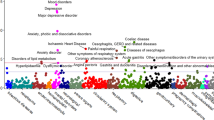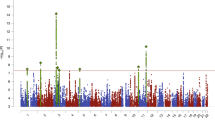Abstract
Several case-control association studies have raised the possibility that the A allele of a −1438 G/A polymorphism in the type 2A serotonin receptor (HTR2A) gene may be a risk factor for anorexia nervosa. However the absence of linkage and the existence of negative association studies raise the possibility of false positive findings, resulting from population stratification or lack of statistical power. To address this controversy we recruited a sample of 316 patients with anorexia nervosa from six European centres, and utilised a family-based transmission disequilibrium (TDT) approach to analyse the HTR2A-1438 G/A polymorphism. Age at onset and minimal BMI were also taken into consideration in order to detect clinical heterogeneity or a quantitative trait effect. The TDT approach showed that the A allele was transmitted 133 times and not transmitted 148 times (McNemar χ2 = 0.29, df = 1, P = 0.59). Also, the haplotype-based haplotype relative risk method showed no evidence for association of the A allele, in samples from each centre (χ2 < 2.15, df = 1, P > 0.14) and in the total sample (χ2 = 0.55, df = 1; P = 0.46). Furthermore, we found no evidence for heterogeneity of the A allele frequency between samples (χ2 = 2.54, df = 4, P = 0.64), either according to minimal-BMI (F1/242 = 2.14, P = 0.45) or age at onset (F1/224 = 2.39; P = 0.12). QTL-TDT analyses also showed no direct role of the A allele on these traits. We thus found no evidence for a significant role of the 5-HT2A gene in anorexia nervosa. Previous results may have been exposed to stratification bias (which we controlled by the TDT method) and/or the risk of type 1 error (from which we were less exposed because of the sample size).
This is a preview of subscription content, access via your institution
Access options
Subscribe to this journal
Receive 12 print issues and online access
$259.00 per year
only $21.58 per issue
Buy this article
- Purchase on Springer Link
- Instant access to full article PDF
Prices may be subject to local taxes which are calculated during checkout
Similar content being viewed by others
References
Gorwood P, Bouvard M, Mouren-Siméoni MC, Kipman A, Adès J . Genetics of anorexia nervosa: a review of candidate genes Psychiatric Genetics 1998 8: 1–12
Fink G, Summer B . Oestrogen and mental state Nature 1996 383: 306
Kaye W . Persistent alterations in behavior and serotonin activity after recovery from anorexia and bulimia nervosa Ann N Y Acad Sci 1997 817: 162–178
Collier D, Arranz M, Li T, Mupita D, Brown N, Treasure J . Association between the 5-HT2A gene promoter polymorphism and anorexia nervosa Lancet 1997 350: 412
Enoch MA, Kaye W, Rotondo A, Greenberg B, Murphy D, Goldman D . 5-HT2A promoter polymorphism −1438G/A, anorexia nervosa, and obsessive-compulsive disorder Lancet 1998 351: 1785–1786
Sorbi S, Nacmias B, Tedde A, Ricca V, Mezzani B, Rotella C . 5-HT2A promoter polymorphism in anorexia nervosa Lancet 1998 351: 1785
Nacmias B, Ricca V, Tedde A, Mezzani B, Rotella CM, Sorbi S . 5-HT2A receptor gene polymorphisms in anorexia nervosa and bulimia nervosa Neurosci Lett 1999 277: 134–136
Hinney A, Ziegler A, Nothen M, Remschmidt H, Hebebrand J . 5-HT2A receptor gene polymorphism, anorexia nervosa, and obesity Lancet 1997 350: 1324–1325
Campbell D, Sundaramurthy D, Markham A, Pieri L . Lack of association between 5-HT2A gene promoter polymorphism and susceptibility to anorexia nervosa Lancet 1998 351: 499
Ziegler A, Hebebrand J, Gorg T, Rosenkranz K, Fichter M, Herpertz-Dahlmann B et al. Further lack of association between the 5-HT2A gene promoter polymorphism and susceptibility to eating disorders and a meta-analysis pertaining to anorexia nervosa Mol Psychiatry 1999 4: 410–412
Sham PC . Statistics in Human Genetics Arnold: London 1998 pp 171–181
Nurnberger JI, Blehar MC, Kaufmann CA, York-Cooler C, Simpson SG, Harkavy-Friedman J et al. Diagnostic interview for Genetic studies: rational, unique features, and training Arch Gen Psychiatry 1994 51: 849–862
Robins L, Wing J, Wittchen HU et al. The composite international diagnostic interview: an epidemiological instrument suitable for use in conjunction with different diagnostic systems and in different cultures Arch Gen Psychiatry 1998 45: 1069–1077
Williams JB, Gibbon M, First MB, Spitzer RL, Davies M, Borus J et al. The Structured Clinical Interview for DSM-III-R (SCID). II. Multisite test-retest reliability Arch Gen Psychiatry 1992 49: 630–636
Robins LN, Helzer JE, Cottler L . NIMH Diagnostic Interview Schedule. Version III-R (DIS-R) Washington University School of Medicine: St Louis, MO 1989
Coners H, Remschmidt H, Hebebrand J . The relationship between premorbid body weight, weight loss, and weight at referral in adolescent patients with anorexia nervosa Int J Eat Disord 1999 26: 171–178
Falk CT, Rubinstein P . Haplotype relative risk: an easy reliable way to construct a proper control sample for risk calculation Ann Hum Gen 1987 51: 227–233
Woolf B . On estimating the relation between blood group and disease Ann Hum Genet 1955 19: 251–253
Spielman RS, McInnis RE, Ewens WJ . Transmission Test for Linkage Disequilibrium: the insulin gene region and insulin-dependent diabetes mellitus (IDDM) Am J Hum Genet 1993 52: 506–516
Abecasis GR, Cardon LR, Cookson WO . A general test of association for quantitative traits in nuclear families Am J Hum Genet 2000 66: 279–292
Risch N, Merikangas K . The future of genetic studies of complex human diseases Science 1996 273: 1516–1517
Masellis M, Basile V, Meltzer MY, Lieberman JA, Sevy S, Macciardi FM et al. Serotonin subtype 2 receptor genes and clinical response to clozapine in schizophrenia patients Neuropsychopharmacology 1998 19: 123–132
Author information
Authors and Affiliations
Consortia
Corresponding author
Rights and permissions
About this article
Cite this article
Gorwood, P., Adès, J., Bellodi, L. et al. The 5-HT2A −1438G/A polymorphism in anorexia nervosa: a combined analysis of 316 trios from six European centres. Mol Psychiatry 7, 90–94 (2002). https://doi.org/10.1038/sj.mp.4000938
Received:
Revised:
Accepted:
Published:
Issue Date:
DOI: https://doi.org/10.1038/sj.mp.4000938
Keywords
This article is cited by
-
Regulation of systemic energy homeostasis by serotonin in adipose tissues
Nature Communications (2015)
-
Genetics of Eating Disorders
Current Psychiatry Reports (2013)
-
A genome-wide association study on common SNPs and rare CNVs in anorexia nervosa
Molecular Psychiatry (2011)
-
Eating disorders: the current status of molecular genetic research
European Child & Adolescent Psychiatry (2010)
-
Contribution of NTRK2 to the genetic susceptibility to anorexia nervosa, Harm avoidance and minimum body mass index
Molecular Psychiatry (2005)



